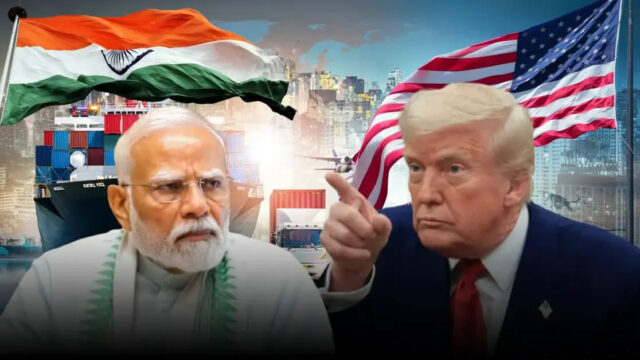The United States has officially enforced a 50% tariff on a wide range of Indian goods, doubling existing duties in what many analysts describe as one of the most severe trade actions against India in recent decades.
The move, announced by President Donald Trump, is aimed at punishing New Delhi’s continued purchase of Russian oil, which Washington argues indirectly funds Moscow’s war in Ukraine.
📉 Impact on India’s Economy
The United States remains India’s largest export destination, with shipments totaling $87.3 billion in 2024. However, experts warn that this steep tariff is comparable to a trade embargo, threatening jobs and crippling small-to-medium exporters.
Industries already feeling the brunt include:
- Textiles & Apparel – mass order cancellations reported.
- Seafood – shipments redirected to rivals in Bangladesh & Vietnam.
- Jewelry – exporters face losses as American buyers withdraw.
Meanwhile, key sectors such as pharmaceuticals, semiconductors, and smartphones remain exempted for now, though ongoing US investigations suggest further levies could follow.
🏛️ India’s Response
New Delhi has strongly condemned the tariffs, calling them “unfair, unjustified, and unreasonable.” Prime Minister Narendra Modi has promised measures to cushion the blow, including lowering tax burdens and accelerating domestic self-reliance programs.
India’s foreign ministry also pointed out that its oil imports from Russia began after Washington itself encouraged the move during the Ukraine war to stabilize global supply. In 2024 alone, 36% of India’s crude imports came from Russia, saving billions and stabilizing domestic fuel prices.
🌍 Strained US–India Relations
The Trump administration has taken a hard stance, with trade adviser Peter Navarro accusing India of “cosying up to Xi Jinping.”
Trade experts warn that this development risks undoing years of progress. Wendy Cutler, Vice President at the Asia Society Policy Institute, noted:
“India moved from a promising candidate for an early trade deal to a nation now facing the highest tariffs imposed by the US against any trading partner.”
She added that the trust deficit created by this trade war may take years to rebuild.
⚖️ What’s Next?
The tariff escalation reflects Trump’s broader strategy of using trade as leverage against both allies and rivals. While countries like Brazil and the EU have also faced fresh tariffs, India’s case is particularly sensitive due to its geopolitical balancing act between Washington, Moscow, and Beijing.
For Indian exporters, the immediate challenge will be finding alternative markets while the government navigates turbulent trade waters.






